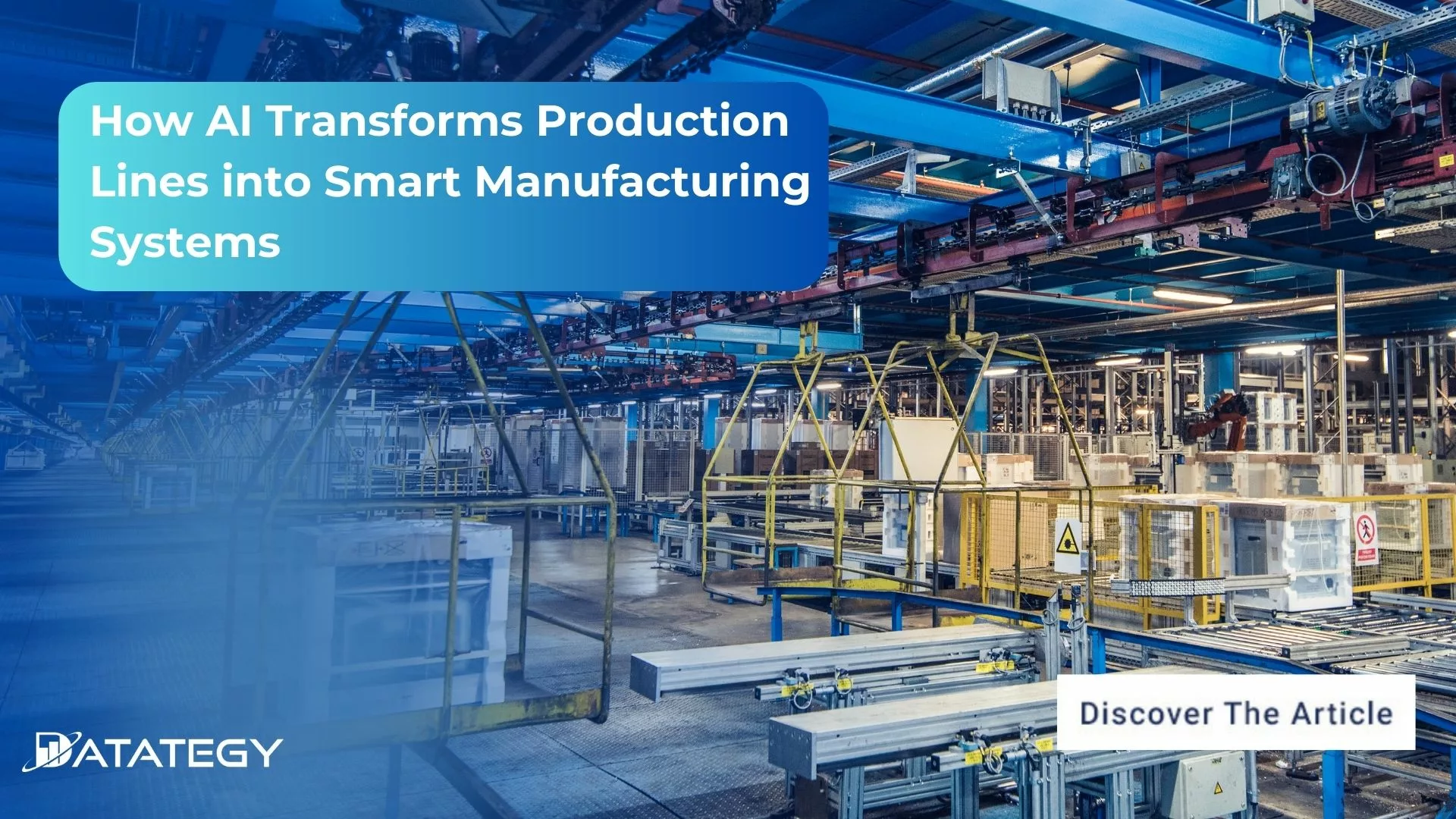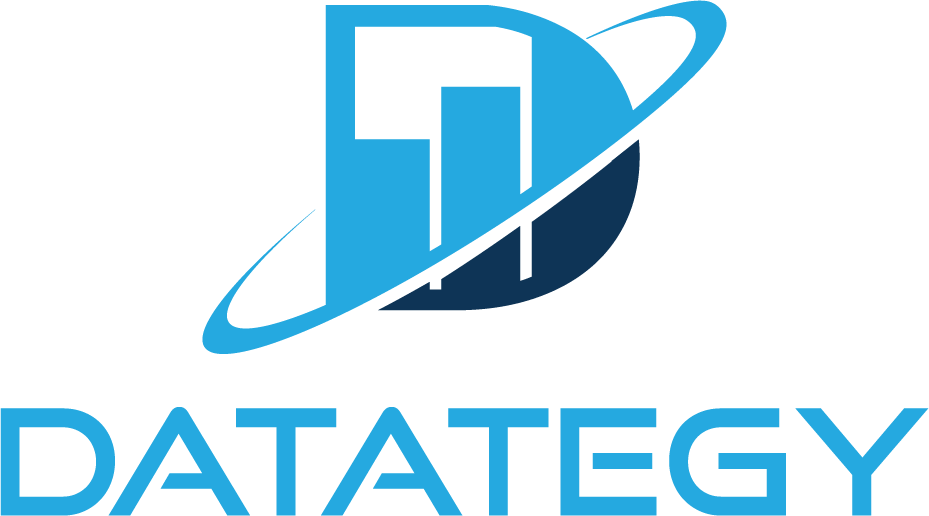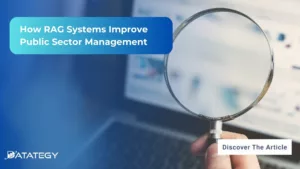How Law Firms Use RAG to Boost Legal Research RAG...
Read MoreHow AI Transforms Production Lines into Smart Manufacturing Systems
Table of Contents
ToggleAI has quickly emerged as a key component of today’s technological environment, and the industrial sector is no exception. Large volumes of data are being produced by industries’ sensors and machinery as a result of the Internet of Things (IoT). AI is in a great position to use this data to enhance industrial processes in meaningful ways.
Production line optimization is one of the most significant ways AI is transforming the industry. Artificial intelligence (AI) systems can detect bottlenecks, forecast equipment breakdowns, and optimize resource allocation by examining historical data and real-time sensor inputs. This results in higher production overall, decreased downtime, and enhanced efficiency.
According to IDC, 𝟯𝟲% 𝗼𝗳 𝗺𝗮𝗻𝘂𝗳𝗮𝗰𝘁𝘂𝗿𝗲𝗿𝘀 have already invested in AI-enabled initiatives and plan to further increase their investments.
Find out how papAI can improve the deployment of AI projects in the Manufacturing Industry.
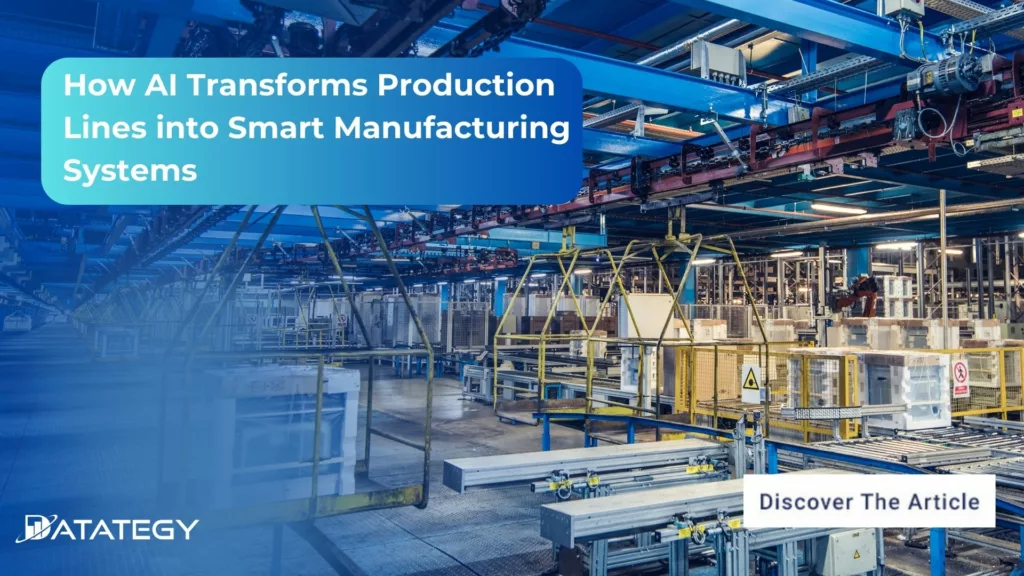
In this article, we look at how AI can improve the production lines in the manufacturing industry.
Historical Overview of the use of Technology on Production Lines
Since the Industrial Revolution in the 18th and 19th centuries, technology has been used in production lines. Manufacturers were able to expand their operations and significantly boost production capacity with the advent of devices like the steam engine.
As technology advanced, computerized systems emerged in the 20th century, giving industrial processes even more control and accuracy. Tasks were further mechanized with the advent of robots in the 1960s and 1970s, which decreased human labor while boosting productivity. By anticipating equipment breakdowns, analyzing massive datasets, and enhancing real-time decision-making, artificial intelligence (AI) and machine learning have become essential in recent decades for production line optimization.
Modern production lines are now more flexible, efficient, and able to react to market needs more quickly than ever before because to AI’s ability to automate repetitive activities and perform predictive maintenance.
What are the Key factors that Impact Production Line Efficiency?
Equipment Performance and Maintenance: Efficiency is greatly impacted by the reliability of the manufacturing line’s machinery. Production can be stopped and supply chain activities disrupted by unplanned downtimes, which are frequently caused by malfunctions. By addressing problems before they arise, predictive maintenance driven by AI helps prevent equipment breakdowns and guarantee uninterrupted output. resupply Material Flow and Chain: Production lines operate smoothly when supply and raw materials are managed effectively.
Production Line Layout and Design: Efficiency can be significantly impacted by the way the production line is set up, including the movement of materials, assembly stations, and workstations. Inadequate layouts cause delays, bottlenecks, and wasteful movement. By reducing pointless motions and matching the appropriate resources to the relevant tasks, AI-driven optimization can assist in the design of production lines that optimize throughput.
Workforce Integration: The level of automation on the production line impacts efficiency. While automation reduces human error and speeds up repetitive tasks, the integration between automated systems and human workers must be seamless. AI and robotics can take over labor-intensive processes, reducing cycle times and enhancing operational efficiency.
What are the Advantages of using Artificial Intelligence in Production Lines Optimization?
Simplified Manufacturing Processes:
By automating repetitive processes that are laborious or prone to errors when done by hand, artificial intelligence is completely changing the way manufacturing lines run. For instance, AI-powered robotics or vision systems may now complete jobs like product sorting, component assembly, or conveyor belt monitoring with previously unheard-of speed and precision. By removing variations brought on by human mistakes or weariness, this automation guarantees constant production and shortens cycle times.
Additionally, businesses can now manage intricate assembly processes where accuracy is crucial thanks to AI-driven technologies. Robots using AI algorithms, for example, can effortlessly assemble complex parts in industries like automobile production, increasing productivity without sacrificing quality. This ensures a seamless transition between activities and speeds up production schedules while minimizing disruptions.
Optimal Use of Resources:
By examining real-time data to determine how labor, materials, and energy are used across the manufacturing line, artificial intelligence (AI) excels at resource management. It guarantees that resources are distributed where they are most required, cutting down on waste and preventing material underuse or overstocking. AI can, for example, forecast the precise amount of raw materials needed for a production run, avoiding overordering and the related expenses of unsold inventory.
By determining the ideal employment numbers based on production plans and periods of high demand, AI also helps labor management. With this knowledge, producers may more efficiently distribute their workforce, preventing idle time or bottlenecks. Artificial intelligence (AI) technologies track power use across machinery in energy-intensive businesses and recommend changes to lower energy consumption while preserving operational efficiency.
Faster Decision-Making:
Faster Decision-Making AI-powered solutions analyze data streams in real-time to provide production managers with information they can act upon. AI technologies, for instance, can identify process inefficiencies or highlight abnormalities in machinery performance, enabling prompt remedial action. Decision-makers are able to keep ahead of possible problems that can impair output quality or interrupt production thanks to these quick insights.
Furthermore, before making adjustments, AI systems may evaluate results by simulating different production scenarios. With the help of this capacity, producers may make proactive decisions and choose the best course of action without having to worry about downtime or resource waste. Businesses may safely make changes that enhance overall production results by using data-driven insights.
What are the Main Technologies Behind the use of AI in Spare Part Search?
Deep Learning Models
Neural networks are used in deep learning, a kind of machine learning, to evaluate and comprehend intricate production data. While Recurrent Neural Networks (RNNs) or Transformers manage time-series data to estimate demand or discover production anomalies, Convolutional Neural Networks (CNNs) are commonly employed in computer vision for defect identification. High-dimensional datasets are processed by these models to provide dynamic manufacturing process optimisation and real-time decision-making.
Edge Computing with AI
Edge computing processes data at the source (such as sensors or machines), bringing AI capabilities closer to the manufacturing floor. By doing this, latency is decreased and quick reactions to modifications in the production environment are made possible. Without requiring high-bandwidth connections to centralized systems, AI models installed on edge devices enable localized control, real-time monitoring, and instant anomaly detection, increasing operational efficiency.
Generative AI
The application of generative AI technologies, such Generative Adversarial Networks (GANs), in process optimization and simulation is growing. To improve process efficiency, these models can test new designs, replicate production scenarios, or optimize layouts. For example, machine learning models for infrequent production events can be trained using synthetic datasets generated by generative algorithms.
Digital Twins Powered by AI
AI is used in digital twins, which are virtual versions of actual manufacturing lines, to model and improve processes. These models evaluate process enhancements, forecast the effects of changes, and identify possible bottlenecks before they materialise in the actual world by utilising real-time data. Strong data-driven choices may be made across the supply chain thanks to AI’s enhancement of digital twins’ predictive and prescriptive capabilities.
How AI is Implemented within your Production Line?
Data Collection and Integration
Since AI depends on data to function, gathering data serves as the foundation for implementation. Real-time data collection is made possible by improved or installed sensors, IoT devices, and industrial equipment. Machine characteristics, environmental measurements, product dimensions, and throughput performance are all included in this data. Data flow across the production environment is guaranteed by integration with current systems, such as MES (Manufacturing Execution Systems) and ERP (Enterprise Resource Planning).
Important technologies used:
IoT sensors for environmental and machine data in real-time.
For localized processing, use edge computing.
Large datasets may be stored and arranged using data lakes.
Data Preprocessing and Analysis
Data must be cleaned and preprocessed after collection in order to eliminate mistakes, duplication, and unnecessary information. For machine learning algorithms to generate reliable results, high-quality, organised data is necessary. During this stage:
AI developers examine past patterns and irregularities in production data.
To extract pertinent inputs for AI models, feature engineering is done.
Data pipelines are designed to guarantee that incoming data is continuously streamed and preprocessed.
Before data is fed into AI algorithms, it is frequently analysed and processed using tools like scikit-learn, TensorFlow, and Apache Spark.
Selecting and Developing Models
AI models are created and trained according to the objectives of the manufacturing process. For the task, particular technologies and techniques are selected:
Convolutional neural networks in computer vision for automated flaw identification and quality assurance.
Machine learning models, such as Random Forest or XGBoost, are used to optimize resource allocation and production scheduling.
Time-series forecasting models, such as LSTM, are used to forecast demand spikes or equipment breakdowns.
Digital twins for manufacturing line simulations in virtual reality.
To guarantee accuracy in forecasting or optimizing real-world situations, machine learning models are trained using past data and verified.
Implementing AI in Production Lines
AI models are introduced into the production line environment following validation. Among the deployment possibilities are:
Cloud-based AI solutions for quick upgrades and scalability.
AI deployment on-premises for delicate or latency-sensitive tasks.
Edge AI tools for quicker decision-making and real-time local analysis.
Integration with current systems, such as PLCs (Programmable Logic Controllers), guarantees AI’s ability to interact and manage machinery in real-time throughout this phase.
AI models may be containerized for effective deployment and administration with the aid of tools like Docker and Kubernetes.
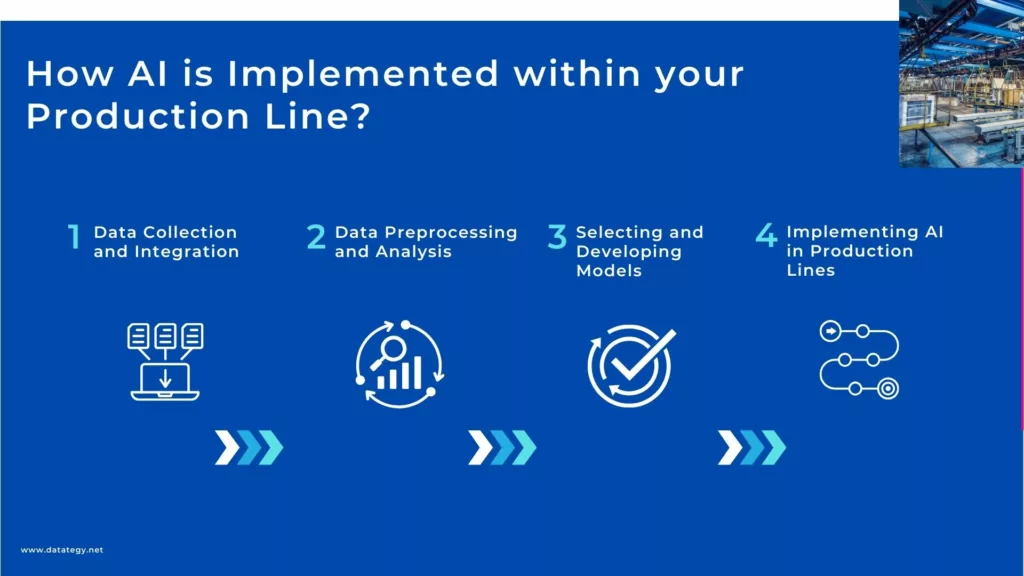
Real-world Examples of how AI is Optimizing Production Lines
General Electric (GE) – Predicting Equipment Failures
AI-driven predictive maintenance has being used by General Electric (GE) to revolutionize the way manufacturing lines handle equipment breakdowns. Conventional maintenance techniques, such as reactive maintenance, which fixes equipment when they breaks, and scheduled maintenance, which services machinery on a regular basis, can lead to unplanned downtime and needless expenses. GE tackles these issues by using AI to anticipate malfunctions before they occur, increasing uptime and reducing downtime.
IoT sensors are installed on industrial equipment to start the process. Performance data, including vibration levels, temperature variations, and pressure measurements, are continually gathered by these sensors. After that, this enormous volume of data is loaded into AI models that have been trained with machine learning techniques to identify trends that point to equipment deterioration or impending failure.
For example, the AI system will notify the maintenance crew to proactively examine and fix the equipment if a machine displays unusual vibration signals. Because maintenance may be planned during off-peak hours to avoid unexpected malfunctions that would stop production, such predictive insights enable minimum interruptions.SourceSiemens – Optimizing Resource Allocation
Siemens has adopted AI to address resource allocation optimization, one of the trickiest parts of production line efficiency. Allocating resources, including labour, materials, and machine time, in a way that optimizes output while lowering expenses is a common challenge for manufacturing facilities. Siemens analyses a variety of factors, including as supply chain data, production schedules, inventory levels, and labor availability, using AI-powered algorithms.
Siemens AI systems use this data to create dynamic, optimized schedules that guarantee the effective use of resources. For instance, the AI may modify schedules to reallocate workloads to more productive machinery if some machines aren’t working up to par. In a similar vein, AI locates important bottlenecks and reallocates human resources to preserve maximum output during labor shortages.
Siemens’ approach’s real-time flexibility is one of its main advantages. The AI system can swiftly adjust schedules and reallocate resources in reaction to unforeseen circumstances, such as interruptions in the supply chain, equipment failures, or urgent client demands. Even under difficult and changing circumstances, manufacturing lines may continue to operate efficiently because of this adaptability.Source
Toyota: Revolutionizing Production Line Optimization with AI and Robotics
Toyota, a leader in manufacturing innovation, has adopted robotics and artificial intelligence (AI) to streamline its production lines and solve long-standing issues with supply chain management, accuracy, and efficiency. Toyota has created a networked and data-driven production environment by using smart manufacturing technology.
In order to increase production, decrease downtime, and simplify operations, this progression integrates robots, AI-powered systems, and machine learning algorithms. Toyota is able to make predicted decisions throughout the manufacturing process by using AI to analyze enormous volumes of production data in real-time.
To guarantee smooth operations on the manufacturing floor, AI-driven solutions, for example, locate bottlenecks, maximize equipment performance, and dynamically modify processes. This flexibility keeps manufacturing lines operating at their best by cutting lead times and improving operational efficiency.Source
Leading the data revolution: CDO role in today's organizations
The need for CDOs is expanding as a result of the growing significance of data in today’s corporate environment. Any organization’s success depends on the CDO, who is the primary force behind digital innovation and change.
Download the full whitepaper to learn more.

How papAI Helps to build Production Line Solution Powered by AI?
From data gathering to deployment, papAI provides a complete, all-in-one platform that unifies all phases of AI development. Traditionally, production line optimization needs various tools and software systems, which can lead to compatibility concerns, inefficient processes, and delays in implementation.
By offering a single location for teams to collect, process, and analyze data as well as create and implement models, papAI removes these obstacles.
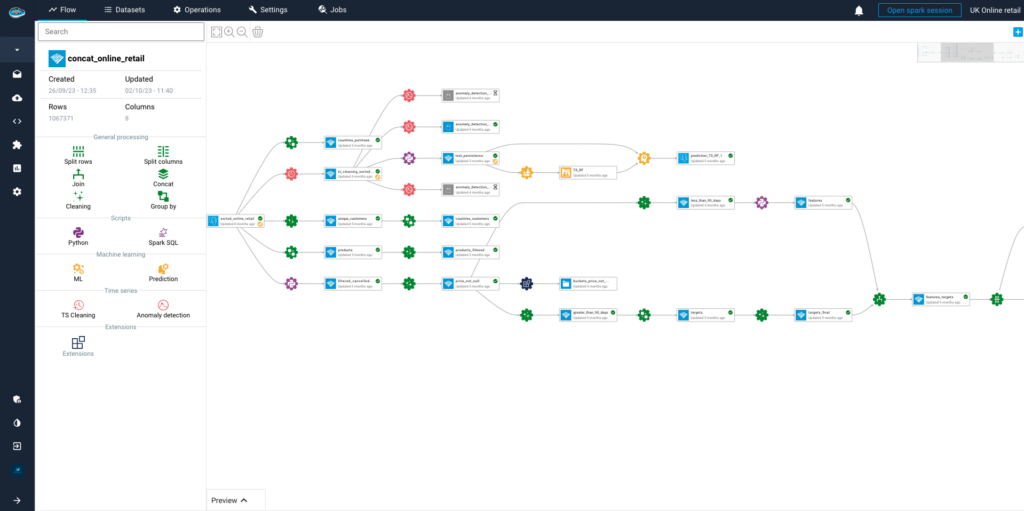
Here’s an in-depth look at the key features and advantages of this innovative solution:
End-to-End Automation for Enhanced Efficiency
papAI greatly increases the efficiency of production lines by automating crucial steps in the AI development and deployment lifecycle. Conventional industrial workflows are frequently beset by manual, repetitive procedures that result in resource waste, sluggish processes, and human error. By automating crucial processes like data intake, feature engineering, model deployment, and performance monitoring, papAI eliminates these inefficiencies.
Businesses may use papAI to build automated pipelines that gather and process data from machines, sensors, and production systems on a continual basis. By ensuring that AI models receive up-to-date inputs, real-time decision-making and increased accuracy are made possible.
Additionally, automation lessens the need for manual interventions, making processes like resource allocation, inventory control, and defect detection more efficient.
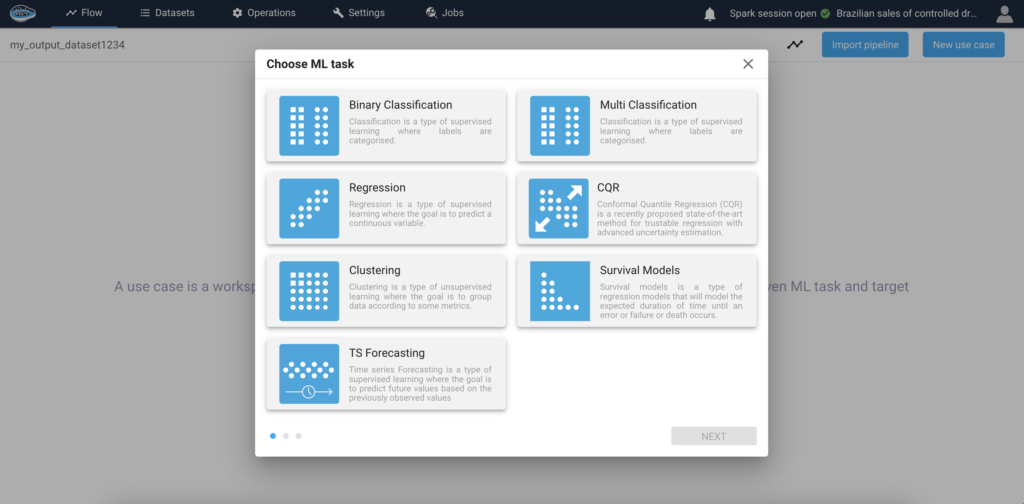
Advanced AI Analytics for Informed Decision-Making
The capacity of papAI to provide actionable information using advanced AI analytics is one of its main features. Conventional production line decision-making frequently depends on static reporting and fragmented data, which does not offer real-time operational awareness. By using machine learning algorithms to handle enormous volumes of data, papAI gets beyond these restrictions and empowers manufacturers to make data-driven choices based on precise, real-time insights.
To find inefficiencies, bottlenecks, and areas for improvement, the platform continually examines data from supply chains, manufacturing machinery, and Internet of Things devices.
For instance, papAI may identify patterns in output quality, resource consumption, and production delays, enabling companies to resolve problems before they become more serious. Interactive dashboards and visualizations provide manufacturers a thorough grasp of their business processes.
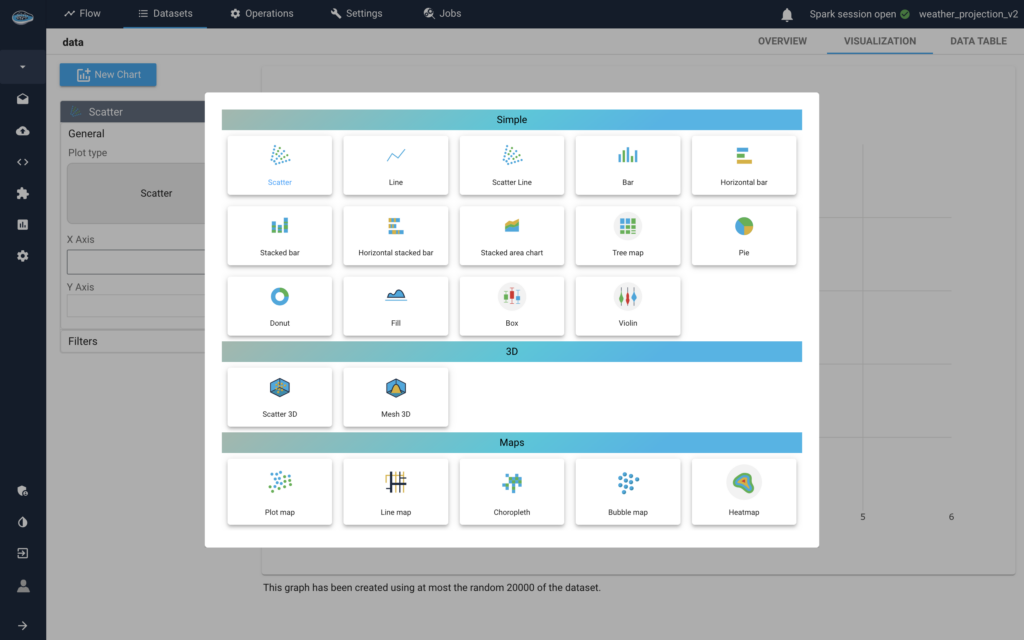
Create Your Own AI-Powered Production Line Optimization with papAI
Through its scalable and automated solutions, papAI streamlines the introduction of AI, improves operational efficiency, decreases downtime, and facilitates more intelligent decision-making. Through process centralization and massive data analysis, papAI enables manufacturers to streamline their operations, cut waste, and enhance product quality, eventually increasing productivity and lowering costs.
Discover how papAI can help you streamline operations, enhance efficiency, and unlock AI’s full potential for your business.
AI significantly enhances production lines by automating processes, minimizing downtime, and improving decision-making. By using machine learning and deep learning algorithms, AI systems analyze large datasets from production environments to identify inefficiencies and optimize workflows.
AI-driven predictive maintenance utilizes real-time data and machine learning algorithms to forecast equipment failures before they occur. By analyzing patterns in machine performance, AI can predict when a part or system is likely to break down, allowing for proactive repairs or replacements.
- AI enables precise resource allocation by continuously analyzing production data to optimize labor, material, and energy usage. Machine learning models can predict the exact amount of raw materials needed for a production run, avoiding overstocking or shortages
- AI can be seamlessly integrated with existing production line systems, such as Manufacturing Execution Systems (MES) and Enterprise Resource Planning (ERP) platforms. By using APIs and IoT devices, AI systems collect real-time data from sensors and machines on the production floor. These insights are then analyzed to optimize resource allocation, predict maintenance needs, and adjust workflows
Interested in discovering papAI?
Our AI expert team is at your disposal for any questions
How RAG Systems Improve Public Sector Management
How RAG Systems Improve Public Sector Management The most important...
Read MoreScaling RAG Systems in Financial Organizations
Scaling RAG Systems in Financial Organizations Artificial intelligence has emerged...
Read MoreHow AgenticAI is Transforming Sales and Marketing Strategies
How AgenticAI is Transforming Sales and Marketing Strategies Agentic AI...
Read More